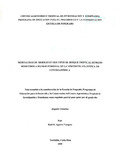Mortalidad de árboles en dos tipos de bosque tropical húmedo sometidos a manejo forestal en la Vertiente Atlántica de Centroamérica
Tree mortality in two managed tropical rain forests in the Atlantic Zone of Central America
Date
1999Auteur
Aguirre Vásquez, Raúl R.
Type
Tesis de maestría
Metadata
Afficher la notice complèteDescription
Tesis (Maestría) - CATIE. Turrialba (Costa Rica), 1999 Ilustraciones. Tablas Referencias de las páginas 81-86
Résumé
La mortalidad natural de árboles en bosques húmedos tropicales manejados sometidos a un aprovechamiento forestal y tratamiento silvicultural, no solo se debió a la muerte de árboles de bajo vigor y crecimiento lento (tendencias en clases de exposición de luz y forma de copa) sino también, y en una mayor proporción, a algún tipo de perturbación (efecto de lianas, aplastados por otros árboles, por daños físicos y por desraizamiento). Se evaluó la dinámica de la población de árboles, tasas de mortalidad natural y causas principales de mortalidad en dos sitios de investigación de operaciones de manejo forestal a largo plazo en Guápiles (Costa Rica) Bosque de Pentaclethra y Micropholis, y en Guabito (Panamá) Bosque de Carapa, Pterocarpus y Pentaclethra, durante 1990-93, 1993-96 y 1996-99, tomando en cuenta los años de aprovechamiento y tratamiento y de post-intervención. En los bosques estudiados, la dinámica de la población actual de árboles para los tratamientos fue analizada mediante curvas de supervivencia, aunque se observaron cambios en la abundancia de los árboles (= 10 cm dap) durante las operaciones de manejo, éstas se restablecieron alrededor del 6to. año debido al ingreso de árboles fustales a clases = 10 cm. El área basal del bosque de Pentaclethra y Micropholis, disminuyó en el tratamiento "liberado" 18 por ciento durante 1990-98 y en un 4 por ciento en el tratamiento "aprovechado". En el bosque de Carapa, Pterocarpus y Pentaclethra, el área basal disminuyó en el Tratamiento Aprovechamiento 29.6 por ciento durante 1990-96 y aumentó en 7.54 por ciento en el Tratamiento Control (sin intervención). Las tasas de mortalidad natural de árboles (= 10 cm dap) en general no difieren significativamente entre los tratamientos aplicados, durante 1990-93, 1993-96 y 1996-99 en las dos clases de bosques. Sin embargo, en el bosque Carapa, Pterocarpus y Pentaclethra a través del tiempo se encuentran diferencias significativas entre el último período y los otros períodos. Las tasas de mortalidad anual fue más alta durante 1990-93 (período de aprovechamiento) en el bosque de Pentaclethra y Micropholis para el tratamiento "aprovechado" con 3.6 por ciento y en el bosque Carapa, Pterocarpus y Pentaclethra en el tratamiento "aprovechamiento" fue de 4.8 por ciento, estos valores resultaron aceptables dentro de un rango de mortalidad de árboles para bosques tropicales maduros intervenidos. Basándose en la información de los dos últimos registros de mortalidad de árboles se encontró que la mortalidad podría estar asociada al efecto de lianas, muerte al ser aplastado por otro árbol o rama, muertos en pie por daños físicos en el fuste o copa, por desraizamiento y muertos en pie sin daños físicos. Los resultados sugieren que modelos de crecimiento y rendimiento no deberían simular la mortalidad principalmente con base en un vigor bajo, sino que deben contemplar altas proporciones de árboles que mueren a causa de una perturbación y que pueden ser de grandes dimensiones y de crecimiento rápido. The natural mortality of trees in a tropical rain forests under logging and silvicultural management depend on the death of trees of low vigor and slow growth (associated with crown exposure and the crown form). At the same time and in a great proportion the death is due to perturbation (liana effect, squashed by other trees, physical damages, and uprooting). The dynamic's population of trees was evaluate, rates of natural mortality and main causes of mortality in two forests with long term research. One is located in Guápiles (Costa Rica), Pentaclethra and Micropholis forest and the other in Guabito (Panama) Carapa, Pterocarpus and Pentaclethra forest during 1990-93, 1993-96 and 1996-99. The current dynamic's population of trees for the liberation treatments were studied trough survival curve. Although changes were observed in the abundance of the trees (= 10 cm dbh) during the handling operations, these recovered around the 6th year due to the recruitment. The basal area in the Pentaclethra and Micropholis forest liberation treatment diminished in 18 percent during 1990-98 and it was only 4 percent in the logging treatment, and in the Carapa, Pterocarpus and Pentaclethra forest also diminished 29.6 percent in the logging treatment during 1990-96 and grew 7.5 percent in the control treatment. The rates of natural mortality of trees (= 10 cm dbh) in general did not differ significantly among the applied treatments, during 1990-93, 1993-96 and 1996-99 in the two forests. However, in the Carapa, Pterocarpus and Pentaclethra forest of through the time there are significant differences among the period of forest logging (1990-93) with last period (1996-99). The rate of annual mortality of 3.6 percent was higher during 1990-93 (period of logging) in the Pentaclethra and Micropholis forest for the logging and in the Carapa, Pterocarpus and Pentaclethra forest it was 4.8 percent in the same treatment. These rates were acceptable within the range of mortality of trees for intervened mature tropical forests. Based on the information of the last two registrations of mortality of trees it was found that the mortality is associate with the lianas effect, death by being smashed by another tree or branch, leaving dead by physical damages in the stem or crown. Other causes were the uprooting and death without physical damages. The results suggest that growth and yield models should not simulate the mortality based in a low vigor, but rather they should include proportions of trees that die because of the perturbation. These trees can be big and of fast growing. Also, that should be considering the physical interactions between environent and organism and their implications with mortality.
Keywords
Asesor
Finegan, Bryan
Éditeur
CATIE, Turrialba (Costa Rica)
Collections
- Tesis [3074]


